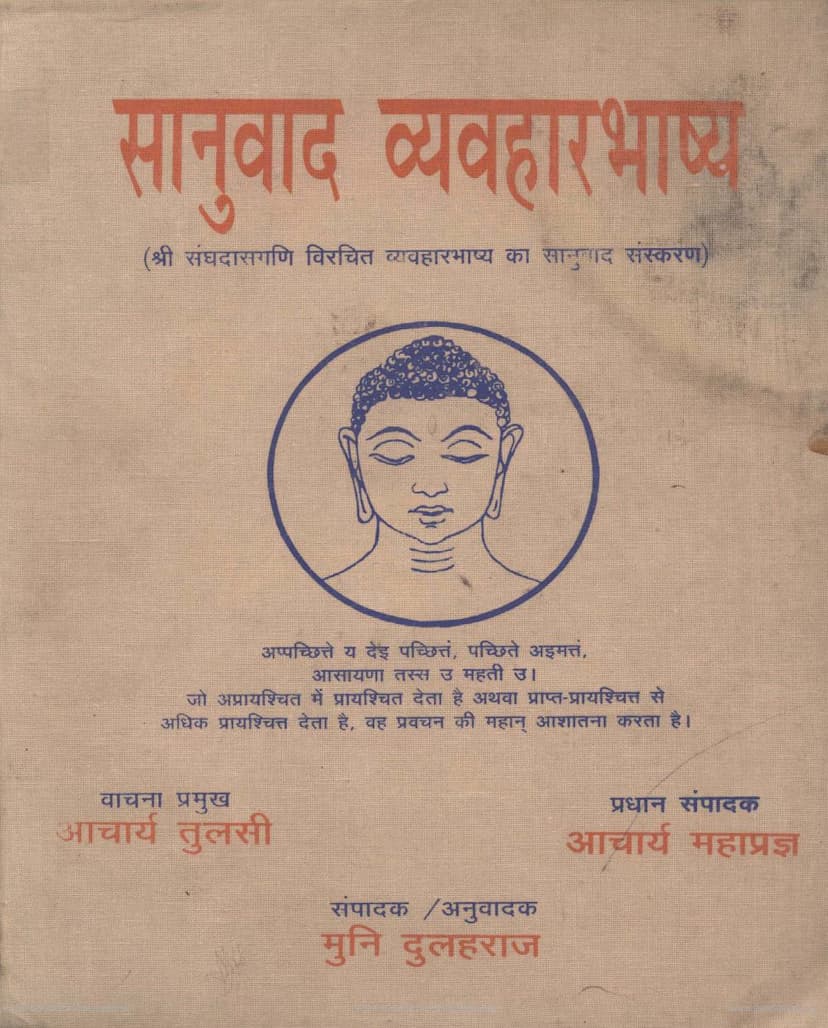Sanuwad Vyavharbhasya
Added to library: September 2, 2025

Summary
The book "Sanvad Vyavharbhasya" by Dulahrajmuni, published by Jain Vishva Bharati, is a Hindi translation and commentary on the original Jain text Vyavahar Bhasya, attributed to Sanghdas Gani. The work was under the spiritual guidance of Ganadhipati Tulsi and the chief editorship of Acharya Mahaprajna.
This comprehensive summary, based on the provided text and the extensive table of contents (pages 12-38), aims to capture the essence and scope of this significant Jain text.
Core Subject and Purpose:
"Sanvad Vyavharbhasya" is primarily concerned with Vyavahar (conduct or behavior) within the Jain monastic order, particularly for monks and nuns. It delves into the intricacies of Jain ethical and disciplinary codes, offering a detailed explanation of the Vyavahar Sutra, which deals with various aspects of monastic life, misconduct, and their respective Prayaschitt (penance or expiation).
The book aims to provide guidance on:
- Utsarg Marg (General Principles): Establishing the standard conduct expected from monks and nuns.
- Apavad Marg (Special Circumstances): Addressing exceptions and specific situations that require deviation from general principles, along with the appropriate penance.
- Dharma Darshan (Jain Philosophy): Illuminating the philosophical underpinnings of Jain conduct, emphasizing the importance of knowledge, right faith, and right conduct (Syadvada).
- Discipline and Ethics: Outlining the rules and regulations governing the monastic community to maintain purity, discipline, and spiritual progress.
Key Themes and Content Covered:
The table of contents reveals the vast scope of the "Sanvad Vyavharbhasya," covering a wide array of topics related to Jain monastic life and discipline:
- Definition and Nature of Vyavahar: The book begins by defining Vyavahar, its types (name, sthapana, dravya, bhava), and the roles of the Vyavahari (practitioner), Vyavahar (the act), and Vyavhartavya (the object of practice). It also explains the etymology of the word 'Vyavahar'.
- Panchalankaras of Jainism: The text emphasizes the importance of Agama, Shruta, Agya, Dharana, and Jeet (five types of Vyavahar) in understanding and practicing the Dharma.
- Prayaschitt (Penance): A significant portion of the book is dedicated to the detailed explanation of Prayaschitt for various transgressions. This includes:
- Types of Prayaschitt: Identifying ten types: Alochana (confession), Pratikraman (recollection and confession), Ubhaya (both), Vivek (discrimination), Vyutsarg (renunciation), Tapa (penance), Chhed (excision), Mool (root cause), Anavasthapya (unsteady state), and Paranchit (outcast).
- Classification of Prayaschitt: Explaining the classification of offenses based on severity (laghu, guru, laghu-guru) and the severity of penance, including the duration (days, months, years).
- Conditions for Prayaschitt: Discussing the circumstances under which penance is prescribed, such as specific times, places, and mental states.
- Manner of Giving Prayaschitt: Detailing how and to whom penance should be administered, the role of the Acharya, Upadhyay, and the importance of sincerity in confession.
- Monastic Conduct and Discipline: The text elaborates on the daily conduct of monks and nuns, including:
- Vinaya (Respectful Conduct): Discussing various forms of Vinaya, such as Kayik (bodily), Vachik (verbal), Mansik (mental), and Aupcharik (formal) Vinaya, with their specific types and prescriptions.
- Samiti and Gupti (Practices of Restraint): Explaining the five Samitis (caution in walking, speaking, eating, etc.) and three Guptis (restraint of mind, speech, and body) and the implications of their transgression.
- Dietary Rules and Practices: Detailing rules related to taking alms, accepting food, dietary restrictions, and the penances for violations.
- Daily Routine and Observances: Covering aspects like Vihartanu (wandering), Nishedha (prohibitions), and their associated rules.
- Monastic Hierarchy and Responsibilities: Outlining the roles and duties of Acharyas, Upadhyayas, Pravartakas, Sthaviras, Ganadharas, and the importance of their guidance.
- Interactions with the Sangha and Laypeople: Addressing the conduct towards fellow monks, nuns, lay supporters, and even against the rules of the Sangha.
- Specific Misconduct and Penances: Detailing offenses like theft, untruthfulness, misconduct with women, anger, pride, deceit, and their corresponding penances.
- Management of Monastic Property and Resources: Including discussions on upadhi (possessions) and their proper usage.
- Dealing with Different Types of Monks: Addressing the conduct towards various types of monks like sadharmika, vitithika, vidagdha, avadha, parikshita, alapa, and the importance of their training.
- Dealing with Obstacles and Calamities: Providing guidance on how to conduct oneself during famine, epidemic, natural disasters, and other adversities.
- Rituals and Ceremonies: Mentioning the significance of rituals like Pratikraman, Alochana, and their procedures.
- Philosophical Insights: The text often interweaves philosophical concepts like karma, rebirth, soul, non-violence (ahimsa), and the ultimate goal of liberation (moksha) with the practical rules of conduct. The importance of right faith, right knowledge, and right conduct is consistently emphasized.
- Storytelling and Examples: Throughout the text, the author uses numerous stories, examples, and analogies from the lives of great monks, enlightened beings (like Rishabhanatha, Mahavir), and even from the natural world to illustrate the principles and the consequences of actions.
Significance and Contribution:
"Sanvad Vyavharbhasya" serves as a crucial text for understanding the practical application of Jain ethical principles for renunciates. It provides a comprehensive framework for maintaining discipline and purity within the monastic community, which is essential for spiritual advancement. The detailed explanation of penances offers a path for atonement and purification for those who err, ensuring the continuity and integrity of the Jain tradition. The translation and commentary by Muni Dulaharaj aim to make this complex and ancient text accessible to a wider audience, particularly Hindi-speaking Jains. The publication by Jain Vishva Bharati highlights its importance in promoting Jain education and scholarship.
Overall, "Sanvad Vyavharbhasya" is a foundational text in Jain monastic literature, offering an invaluable resource for monks, scholars, and anyone interested in the depth and rigor of Jain ethical and disciplinary practices.